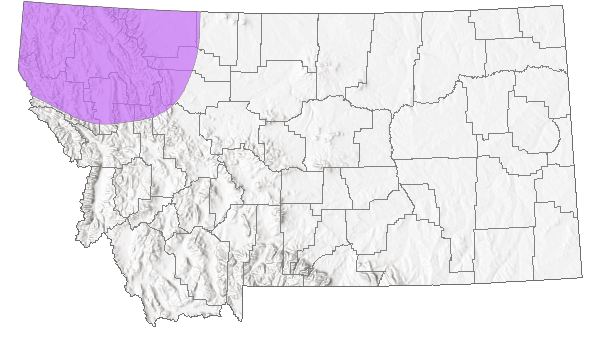View in other NatureServe Network Field Guides
NatureServe
Montana
Utah
Wyoming
Idaho
Wisconsin
British Columbia
South Carolina
Yukon
California
New York
Brunner's Grouse Locust - Tetrix brunnerii
General Description
The following is taken from Helfer (1971), Vickery and Kevan (1985), and Bland (2003). This species is stockier and more robust than other Tetrix occurring in Montana. Its body color can be blackish to yellowish or variously patterned and marked. The pronotum is somewhat humped in profile and can be short or long extending to the abdominal tip. However, 80% of all specimens collected possess short pronotums extending to about half the abdominal length.
Phenology
Overwinters in the adult stage. Overwintering adults occur from April to August or September, but disappear in midsummer, and are then succeeded by the next generation in late summer and autumn (Helfer 1971, and Vickery and Kevan 1985).
Diagnostic Characteristics
Pronotal length for males is 8.3 mm to 11.8 mm, and females 9.5 mm to 13.5 mm. Middle leg femur robust, 3-3.4 times as long as broad (Helfer 1971, Vickery and Kevan 1985, and Bland 2003).
This species is easily confused with the other Montana Tetrix.
Species Range
Montana Range
Range Descriptions

 Native
Native
Range Comments
From Alaska eastward across the Canadian Provinces to Labrador and from Idaho across the northern states to Maine, southward to Utah, Colorado, Michigan and New York. Very boreal in distribution. In Montana, reported for only one county (Helfer 1971, and Vickery and Kevan 1985).
Habitat
Inhabits lush meadows and bogs in forested areas.
Food Habits
Unknown. Probably similar to
Slender Grouse Locust (
T. subulata).
Reproductive Characteristics
Unknown. Probably similar to
Slender Grouse Locust (
T. subulata).
Stewardship Responsibility
References
- Literature Cited AboveLegend:
 View Online Publication
View Online Publication Bland, R.G. 2003. The Orthoptera of Michigan—Biology, Keys, and Descriptions of Grasshoppers, Katydids, and Crickets. East Lansing, MI: Michigan State University Extension, Bulletin E-2815. 221 p.
Bland, R.G. 2003. The Orthoptera of Michigan—Biology, Keys, and Descriptions of Grasshoppers, Katydids, and Crickets. East Lansing, MI: Michigan State University Extension, Bulletin E-2815. 221 p. Helfer, J.R. 1971. How to Know the Grasshoppers, Crickets, Cockroaches, and Their Allies. Revised edition (out of print), Mineola, NY: Dover Publications.
Helfer, J.R. 1971. How to Know the Grasshoppers, Crickets, Cockroaches, and Their Allies. Revised edition (out of print), Mineola, NY: Dover Publications. Vickery, V. R. and D. K. M. Kevan. 1985. The grasshopper, crickets, and related insects of Canada and adjacent regions. Biosystematics Research Institute, Ottawa, Ontario. Publication Number 1777. 918 pp.
Vickery, V. R. and D. K. M. Kevan. 1985. The grasshopper, crickets, and related insects of Canada and adjacent regions. Biosystematics Research Institute, Ottawa, Ontario. Publication Number 1777. 918 pp.
- Web Search Engines for Articles on "Brunner's Grouse Locust"
- Additional Sources of Information Related to "Insects"





